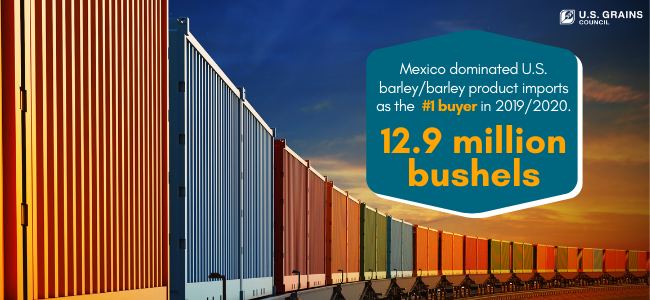The U.S. Grains Council (USGC) recently connected company representatives from the three largest Mexican breweries with the three largest U.S. barley-producing states – North Dakota, Montana and Idaho – to receive a crop report directly from U.S. farmers and updates on the latest in research and development for barley and malt.
“Just as we have been doing with feed producers, we are taking our buyers to hear directly from U.S. farmers and suppliers about the current year’s crop, quality and other information,” said Javier Chavez, USGC marketing specialist for Mexico. “In turn, customers can ask questions about market factors, supply and demand issues related to COVID-19 while providing their own outlook on Mexican beer production.
“By providing market information and education, we are able to better reach out to our end-users. We now have brewers asking for updated information on U.S. barley varieties and U.S. malt suppliers, as well as for help on specific trade projects.”
Mexico is the world’s largest beer exporter in terms of both value and volume – good news for U.S. barley farmers and malt producers who supply the main ingredient. Mexico dominates imports of U.S. barley and barley products, purchasing 350,000 metric tons (12.9 million bushels) in 2019/2020.
The outbreak of COVID-19 essentially shut down the brewing industry in Mexico in spring 2020 as beer production was deemed a non-essential industry. Some brewers near the border and in rural areas could operate, but malt imports quickly dropped to a third of normal demand.
As these large companies have resumed production, the Council has stayed in close contact with key customers to stay tuned-in to their concerns. The shift to a virtual setting for this program meant the Council could not only answer questions, but also expand participation to include more staff from each of the companies as well as more presence from members of the U.S. barley and malt supply chain.
“This business-to-business approach takes advantage of the virtual nature of meetings to make it easy to include more participants from both sides of the border,” Chavez said. “We can go beyond procurement staff to include other individuals from these Mexican companies working in research and development, quality control and management. At the same time, we can include a larger number of U.S. farmers, maltsters, researchers and suppliers.”
The Council has follow-up programs scheduled with each individual brewing company to address specific needs identified through this virtual meeting.
“Through these programs, we reaffirm the Council as a source of education, market information and an active partner in enabling trade,” Chavez said. “As a result, we have more inquiries than ever from brewers, feed producers and grain importers.”
Learn more about the Council’s work to promote U.S. barley and malt in Mexico.
About The U.S. Grains Council
The U.S. Grains Council develops export markets for U.S. barley, corn, sorghum and related products including distiller’s dried grains with solubles (DDGS) and ethanol. With full-time presence in 28 locations, the Council operates programs in more than 50 countries and the European Union. The Council believes exports are vital to global economic development and to U.S. agriculture’s profitability. Detailed information about the Council and its programs is online at www.grains.org.

